



The Pekingese, otherwise known as the “lion dog,” originated from China. This dog breed is part of the UKC, Companion breed, and the AKC, Toy breed. The Pekingese dog breed has been around in China since the Tsang Dynasty, during the eighth century. The nobility enjoyed this dog breed.
Brief History
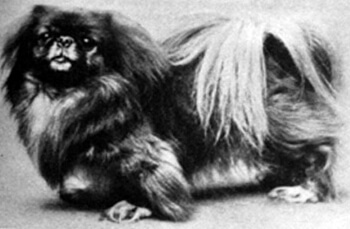
The Pekingese has three names: lion dog, sun dog, and sleeve dog. These three names refer to the Pekingese’s heavy mane, the golden red color, and its small size, allowing for sleeve portability. Theft of a Pekingese was punishable by death. This dog breed first arrived in the U.K during the 1860’s. This happened when the Brits looted the Imperial Palace, and British troops invaded Peking.
Five surviving Pekingese dogs were brought back to the U.K. During the invasion the royal family killed their Pekes, but five hid behind draperies. The Brits adored this dog breed, after Queen Victoria welcomed the first five Pekes. The first Pekingese arrived in the U.S by the late 1890’s. The Pekingese were first registered with the AKC in 1906.
Breed Description
The Pekingese is a stocky, small dog. It is heavy, well-balanced, and compact. This small dog breed is lion-like, and muscular. This dog breed has a heavy front, and a lighter posterior. With a broad head, wrinkled, short muzzle, the Pekingese has a broad jaw. The skull is rectangular, with drop ears that are heart-shaped. There is heavy fringing on the face. The eyes are large, and round.
The neck is short, and the feet flat and outward turned. The Pekingese has short, bowed legs, with a broad chest. The tail is upright, and curled backwards. The coat is double- coated with a thick, soft undercoat. It is long, and coarsely textured. The coat can either be red, fawn, black, black and tan, or white. The Pekingese will sometimes have a “spectacle”-like mask on the face. The Pekingese has a dignified, free gait. The temperament is regal and independent.
Temperament
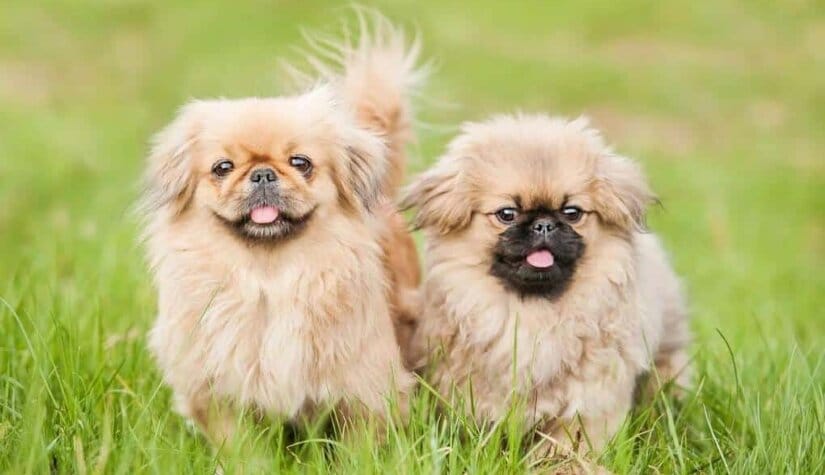
The Pekingese is totally independent, and can sometimes be stubborn. This regal dog breed does not do well with small children, or with other dogs. It’s best to socialize the Pekingese during the first four weeks of puppyhood, so that this dog breed will make every effort to get along with other dogs, and people later on in life. This is a good tempered dog breed with family, and friends.
Positive dog training needs to start early since this dog breed is stubborn. The charming Pekingese will form close bonds with his dog parent. The Pekingese adores being pampered, and does enjoy visiting Starbucks for a Puppuchino. This dog breed makes for the perfect companion at restaurants, and on dog vacays!
Special Needs
The Pekingese needs plenty of socialization, and positive training from puppyhood. This dog breed does best with daily exercise combined with mental stimulation. The Pekingese loves taking part in canine sporting activity even though it is a small dog breed. This breed does well with apartment living. There are anesthesia concerns with this dog breed, as well as heat sensitivity concerns. Daily grooming maintenance and care for this dog breed is necessary. The Pekingese suffers from brachycephalic syndrome, and should not fly in cargo, but in cabin instead. Always consult with your veterinarian prior to flying with your Pekingese.
Possible Health Concerns
The Pekingese is an active and healthy dog breed that may be susceptible to the following health conditions:
- Anesthesia Sensitivity: Pekingese have a hard time handling anesthesia. Because the Pekingese is a small Toy breed, extra care must be given when administering anesthesia to this dog breed. This is a brachycephalic dog breed that suffers from brachycephalic airway syndrome. This makes it hard for them to inhale air. All Toy breeds need to be properly intubated prior to anesthesia.
- Heat Sensitivity: The Pekingese is heat sensitive. Heat stroke in dogs is when collapse is brought on by prolonged periods of heat stress or heat exhaustion. Symptoms will include cessation of sweating, panting, high body temperature, and even unconsciousness. Consult with your veterinarian for advice.
- Corneal Ulceration: This is when the cornea becomes inflamed and swollen. The cornea surface will have sores that take a long time to heal. The membrane that covers the inner surface of the cornea may protrude through the cornea. The ulcer can also form a hole in the cornea. Consult with your veterinarian.
- Invertebral Disk Disease: This is a degenerative disease of the spinal column. It results in compression of the spinal cord, and spinal nerves. It is common in the Pekingese dog breed. Spinal disks can begin to degenerate during adolescence. “Slipped disks” can affect the Pekingese during the first year to two years of life. Some symptoms may include muscle weakness, paralysis, loss of motor control, pain and stiffness. Consult with your veterinarian for treatment.
- Stenotic Nares: This is a common disorder in the Pekingese, and in all Brachycephalic dog breeds. This is a genetic condition, and is the result of cartilage malformation around the nose. The “nostrils” are too narrow. There is increased airway resistance in breeds that breath through their mouths. Symptoms include noisy breathing, blue gums, exercise intolerance, and fainting. Treatment may involve surgery, combined with the right care and exercise program. Consult with your veterinarian.
Exercise
The Pekingese needs a moderate to low amounts of exercise, and does well with several, casual strolls around the block. That said, this dog breed still needs plenty of mental stimulation and attention. Opt for dog parks, mini hikes, and camping trips with the family. Although this breed is a Toy breed, it also does well with suitable organized canine activities. The Pekingese enjoys taking everything slowly, but needs a regular exercise schedule so as to prevent excessive weight gain. Doga and Doglates are also fun ways for the entire family to have fun with this regal dog breed.
Nutrition
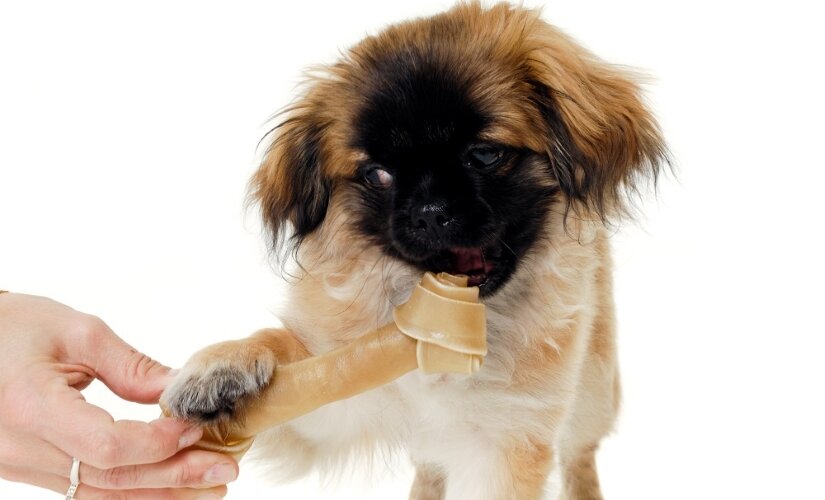
A high-quality diet helps your Pekingese fight disease, grow correctly, and age well. That said, with so many dog foods available, there are numerous healthy options. A high-quality dog food has the power to heal; yet that healing is totally dependent on the quality of the ingredients in each dog food recipe. Dog food recipes are also constantly changing, and it’s up to very dog parent to read the ingredient label carefully.
Elderly Pekingese dogs need to be on a senior dog food formula. The Pekingese gains weight easily. Consult with your veterinarian as to the best dog food formula for your dog. Consider home-cooking for your Pekingese with organic, natural foods.
Here’s what to look for when choosing a high-quality dog food for your Pekingese:
- Look for dog foods that are tested using the AAFCO feeding trials instead of by formulation.
- Look for the nutritional adequacy statement that is required on all pet food labels.
- This label provides answers to three most important questions about your pet food.
- If it’s complete and balanced
- What life stage is it intended for? (Puppy, senior)
- How the claims on the label are substantiated?
- Healthy ingredients
- Fresh meat
- Vegetables and fruit
- No controversial ingredients
- No added hormones and steroids
- No unnamed meat sources
- Right ratio of macronutrients
- By-products in dog food are fine when they are organ meats
- Dog food should not be overly processed
Some dog food diets like the dehydrated do not contribute to plaque buildup since they do not contain sugars, salt, or added preservatives. That said, keep in mind that smaller dog breeds like the Pekingese tend to have more dental issues. With that in mind, it’s best to check the ingredients list carefully.
Grooming
As with any dog breed, long or short haired, daily grooming for the Pekingese is a must! Daily grooming also promotes bonding with your dog. The Pekingese has a double coat that is thick, and sheds. Dogs tend to chew on matted fur, and then develop skin conditions. Dirty coats also promote parasites and sores. That said, the Pekingese needs extra maintenance when it comes to coat care. Pekingese do mat, and need to be groomed and bathed regularly.
With the latest grooming tools and grooming tables available online today, grooming your Pekingese at home can be fun and relatively easy. Goat milk all-natural shampoo soaps are a healthy option to control dog odors. Some natural products containing goat milk also deter fleas and ticks, and help prevent hot spots and flaky skin.
The Pekingese will need to have nails trimmed regularly. Ears need to be kept clean by wiping with a cotton ball or canine wipe, and an ear-cleanser made especially for dogs. That said, daily teeth brushing is required with doggie toothpaste and a dental brush. The Pekingese develops gum disease easily from tartar buildup.
Adopting a Pekinese
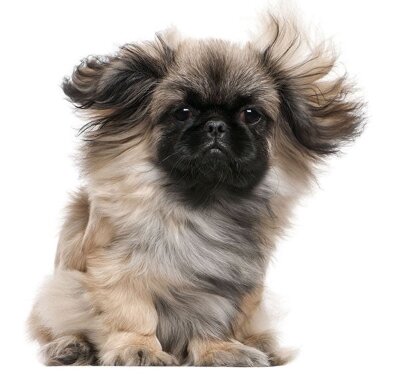
You and your Pekingese will spend a lifetime together! The human-dog bond between a Pekingese and human is strong. This dog breed bonds very closely with his dog parent. With so many dogs up for adoption, many dog lovers have decided that adoption is the only way to go.
In the weeks post- adoption, you may face a few behavioral problems. These are easily overcome, most especially with a breed like the Pekingese that learns quickly, although stubborn. Canine depression, excessive barking, and possible house-training issues in male Pekingese may arise. Consult with your veterinarian if your Pekingese demonstrates excessive anxiety. Prozac or melatonin may be prescribed to help ease your dog’s stress level.
The Pekingese makes for a great adoption in the right home environment with older children. Puppy training should start early because this dog breed can be stubborn and arrogant. Some dogs at the shelter may have special needs like weakened immune systems, gum disease, or other health problems. Visit your veterinarian after adoption for a complete health check to rule out any pre-existing health conditions. That said, you’ll be able to work through any behavioral issues, knowing that they are not health related in any way.
As usual, make sure that you have the time and resources to take good care of your Pekingese before adopting!
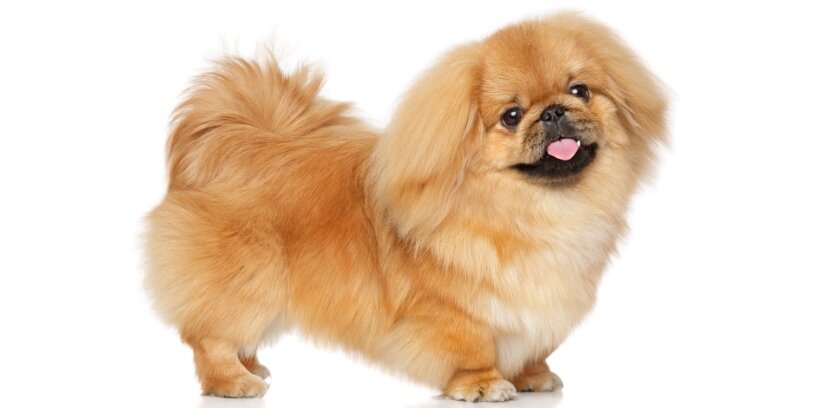
Thx so much for this information, My peaks name is Harry and when I move he moves. I love my sweetheart baby Boy .i look into all info about him, so again thx so much and God bless you…
Pekingese are beautiful dogs. I happen to have my first one who is 10 yrs old. Her bff who’s a 9 year old pug get along very well ❤
I just wanted to share that I love dogs and animals😊
I have a beautiful pieke in and out . She has her own mind but knows when I mean business. Unlike some she is great with children who respect and love animals. Caliegh is seventeen and is in her senior years and given good kibble and food also . Regular boiled organic chicken and this has helped her reach her years. But pieke’s need lots of love. She is my sweet little girl❤️
Jeannie, I also have my first Pekes! They arrived 17 March 2020, mother father and son all needing a good home. I’ve never owned pekingese before ( ….hard-core Rottweiler owner! What a difference!!) but these little ones are the masters of my heart. Really and truly. Yes, I’m kept busy grooming, a little sheepish when I have to take them out in their stroller, and a sunny day in the garden involves sun shades, doggy loungers, iced water, chilled cool mats, but I wouldnt have it any other way!! Best of luck with your little one!
I have a pekinese named china
She is my love. She is fourteen now but strong. Ive had her since she was a puppy.
It warms my heart reading about all the loved Pekingese out there. They are the most amazing breed .I love my Queen Sheba , she is the master and i happily slave to her …lol